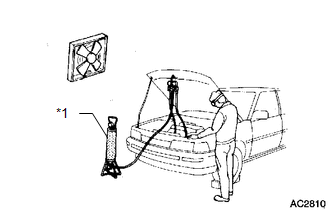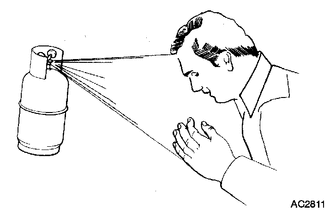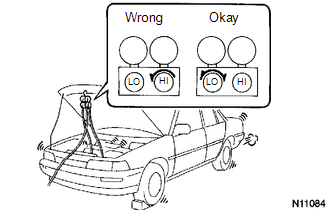Toyota Venza: Precaution
PRECAUTION
NOTICE:
When disconnecting the cable from the negative (-) battery terminal, initialize the following systems after the cable is reconnected.
|
System Name |
See Procedure |
|---|---|
|
Back Door Closer System |
|
|
Power Back Door System |
1. EXPRESSIONS OF IGNITION SWITCH
(a) The type of ignition switch used on this model differs according to the specifications of the vehicle. The expressions listed in the table below are used in this section.
|
Switch Type |
Ignition Switch (Position) |
Engine Switch (Condition) |
|
|---|---|---|---|
|
Expression |
Ignition switch off |
LOCK |
Off |
|
Ignition switch ON |
ON |
On (IG) |
|
|
Ignition switch ACC |
ACC |
On (ACC) |
|
|
Engine Start |
START |
Start |
|
2. DO NOT HANDLE REFRIGERANT IN AN ENCLOSED AREA OR NEAR AN OPEN FLAME
 Text in Illustration
Text in Illustration
|
*1 |
Charging Cylinder |
3. ALWAYS WEAR EYE PROTECTION
4. BE CAREFUL NOT TO GET LIQUID REFRIGERANT IN YOUR EYES OR ON YOUR SKIN

If liquid refrigerant gets in your eyes or on your skin:
(a) Wash the area with lots of cold water.
CAUTION:
Do not rub your eyes or skin.
(b) Apply clean petroleum jelly to the skin.
(c) Go immediately to a hospital or see a physician for professional treatment.
5. NEVER HEAT CONTAINER OR EXPOSE THE CONTAINER TO AN OPEN FLAME
6. BE CAREFUL NOT TO DROP CONTAINER OR APPLY PHYSICAL SHOCKS TO IT
7. DO NOT OPERATE COMPRESSOR WITHOUT ENOUGH REFRIGERANT IN REFRIGERANT SYSTEM

If there is not enough refrigerant in the A/C system, oil lubrication will be insufficient and the compressor may be damaged.
Necessary care should be taken to avoid this.
8. DO NOT OPEN HIGH PRESSURE MANIFOLD VALVE WHILE COMPRESSOR IS OPERATING
(a) Open and close only the low pressure valve.
If the high pressure valve is opened, refrigerant flows in the reverse direction causing the charging cylinder to rupture.
9. BE CAREFUL NOT TO OVERCHARGE SYSTEM WITH REFRIGERANT
If refrigerant is overcharged, it causes problems such as insufficient cooling, poor fuel economy, engine overheating, etc.
10. DO NOT OPERATE ENGINE AND COMPRESSOR WITH NO REFRIGERANT
CAUTION:
Doing so may damage inside the compressor because the compressor parts always move regardless of whether the A/C system is turned on or off.
11. SUPPLEMENTAL RESTRAINT SYSTEM (SRS)
(a) This vehicle is equipped with an Supplemental Restraint System (SRS) such
as the driver, front passenger, side, and curtain shield airbags. Failure to carry
out service operations in the correct sequence could cause the SRS to unexpectedly
deploy during servicing, possibly leading to a serious accident. Before servicing
(including removal or installation of parts, inspection or replacement), be sure
to read the precautionary notices (See page .gif)
).
12. GENERAL PRECAUTION
(a) While using the battery during inspection, do not bring the positive (+) and negative (-) tester probes too close to each other as a short circuit may occur.
 Parts Location
Parts Location
PARTS LOCATION
ILLUSTRATION
ILLUSTRATION
ILLUSTRATION
...
Other materials about Toyota Venza:
Center Power Outlet Socket
Components
COMPONENTS
ILLUSTRATION
Installation
INSTALLATION
PROCEDURE
1. INSTALL CENTER POWER OUTLET SOCKET COVER
(a) Engage the 2 claws to install the center power outlet socket cover.
2 ...
Removal
REMOVAL
CAUTION / NOTICE / HINT
HINT:
Use the same procedure for the LH side and RH side.
The following procedure listed is for the LH side.
PROCEDURE
1. REMOVE FRONT WHEEL
2. DRAIN BRAKE FLUID
NOTICE:
If brake fluid leaks onto any pa ...
Speaker Output Short (B15C3)
DESCRIPTION
This DTC is stored when a malfunction occurs in the speakers.
DTC No.
DTC Detection Condition
Trouble Area
B15C3
A short is detected in the speaker output circuit.
...
0.1659

